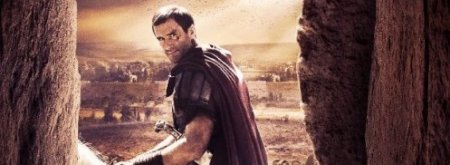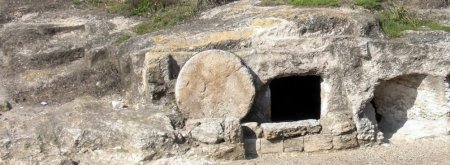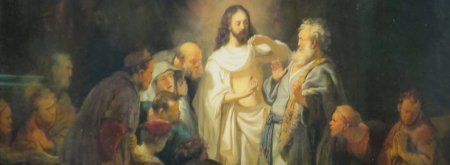The Resurrection Factor
In the last session together, we saw that the background for a lot of what I will be sharing came out of my struggle to refute Christianity. In that struggle, I came to the conclusion that the resurrection is an historical fact – that Christ was crucified, buried and literally raised from the dead on the third day. I didn't want to believe that, but I ended up believing it. Then we saw how Jesus predicted His resurrection. We saw some of the motives of the problems that led up to why Christ was crucified, at least looking at it from a human perspective.
Now what I'd like to here is go to the scriptures with a very long passage. As I am reading this passage and you are reading it on the screen, it can be very easy for your mind to wander because you've probably read it before. But I'm going to ask you to hone in and to listen to it carefully and to think it through. Don't just listen to it and read it, but think the passage through. And then I want to come back and we will start looking at some of the details of what we have literally read here in the word of God. In the Book of Matthew, chapter 27 commencing with verse 33:
And when they had come to a place called Golgotha, which means Place of the Skull, they gave him wine to drink, mingled with gall and after tasting it he was unwilling to drink. And when they crucified Him, they divided up His garments among themselves casting lots. And sitting down, they began to keep watch over Him there. And they put up above His head, the charge against Him, which read, "This is Jesus, the King of the Jews." At that time, two robbers were crucified with Him; one on the right and one on the left. And those passing by were hurling abuse at him wagging their heads and saying, "You, who are going to destroy the temple and rebuild it in three days, save yourself. If you are the Son of God, come down from the cross." In the same way, the chief priests also were mocking Him, along with the elders and saying, "He saved others; He cannot save Himself. He is the King of Israel? Let Him now come down from the cross and we shall believe in Him. He trusts in God; let Him deliver Him now if he takes pleasure in Him, for He said I am the Son of God."
I want to go over now to verse 57:
And when it was evening, there came a rich man from Arimathea named Joseph who himself had also become a disciple of Jesus. This man went to Pilate and asked for the body of Jesus. Then Pilate ordered it to be given over to him and Joseph took the body and wrapped it in a clean linen cloth and laid it in his own new tomb, which he had hewn out in a rock. And he rolled a large stone against the entrance of the tomb and went away. And Mary Magdalene was there and the other Mary sitting opposite the grave. Now on the next day, which is the one after the preparation, the chief priests and the Pharisees gathered together with Pilate and said, "Sir, we remember that when He was still alive that deceiver said, 'After three days, I am to rise again.' Therefore give orders for the grave to be made secure until the third day lest the disciples come and steal him away and say to the people He has risen from the dead and the last deception will be worse than the first." Pilate said to them, "You have a guard. Go. Make it as secure as you know how." And they went and made the grave secure and along with the guard, they set a seal on the stone. Now after the Sabbath as it began to dawn toward the first day of the week, Mary Magdalene and the other Mary came to look at the grave and behold a severe earthquake had occurred. For an angel of the Lord descended from heaven and came rolled away the stone and sat upon it. And His appearance was like lightning and his garments as white as snow. And the guards shook for fear of Him and became like dead men. And the angel answered and said to the women, "Do not be afraid for I know that you are looking for Jesus, who has been crucified. He is not here for He is risen just as He said. Come see the place where He was lying. And go quickly and tell His disciples that He has risen from the dead and behold He is going before you into Galilee. There you will see Him. Behold, I have told you."
And they departed quickly from the tomb with fear and great joy and ran to report it to His disciples. And behold, Jesus met them and greeted them. And they came up and took hold of his feet and worshipped Him. Then Jesus said to them, "Do not be afraid. Go and take word to my brethren to leave for Galilee and there they shall see me." Now while they were on their way, behold, some of the guard came into the city and reported to the chief priests all that had happened. And when they assembled with the elders and counseled together, they gave a large sum of money to the soldiers and said, "You are to say 'His disciples came by night and stole Him away while we were asleep.' And if this should come to the governor's ears, we will win him over and keep you out of trouble." And they took the money and did as they had been instructed and this story was widely spread among the Jews and is to this day.
That is the Biblical account of the resurrection of Christ. Now what I'd like to do is share with you some of the historic details that will add some understanding to what the word of God records here. It says that Christ died of crucifixion. His hands, in other words, about right here, His hands and His feet were pierced against a cross. Crucifixion was probably one of the most cruel deaths that anyone could ever face.
The historian, Flavius Josephus, records that a whole barrack of soldiers surrendered with the pledge that when they were killed, they would not be crucified. That's how much people feared crucifixion. It was such a horrible death that Roman citizens were excluded from ever being crucified. This is something that the Jews feared and to the Jew, to be crucified, to be hanged in a tree, was to be cursed of God. Now before they crucified someone they would often whip them. It tells about in the scriptures that they took and flogged, they whipped Jesus after the verdict that He should be killed and buried. The customary way of whipping was they had a long handle and tied in to the end of the handle were a number of leather strips going up. At the end of the leather strips, they would take one of two things, either jagged bone or sharp pieces of rock and slice down the strips of leather and they would tie the bone or the rock into the end of the leather so the sharp, jagged edges would stick out. Then they would strip the prisoner, like Jesus was, stripped of his clothes on his back and then they would usually whip and hit them about thirty nine to forty times. They would take the whip, and they would hit it above the shoulders. Each one of the leather straps were a different distance so that when you whip somebody, it would not clog up and have just one or two hit him, but they would all hit simultaneously. And they would strike them like this and then it would hit the back, they would yank the whip down and it would start to unravel the skin on the back of the prisoner.
A medical doctor by the name of Dr. C. Truman Davis did tremendous research on the medical perspective of whipping and what happened to a person when the Roman flagrum, or whip, was used. I would like to share with you some of the results that Dr. Davis found:
The heavy whip is brought down with full force again and again across a person's shoulders, back and legs. At first, the heavy thongs cut the skin only. Then as the blows continue, they cut deeper into the subcutaneous tissues producing first an oozing of blood from the capillaries and the veins of the skin, and finally, spurting arterial bleeding from vessels in the underlying muscles. The small balls of lead or rock or bone first produce large, deep bruises, which are broken open by subsequent blows. Finally, the skin of the back is hanging in long ribbons and the entire area is an unrecognizable mass of torn, bleeding tissue. When it is determined by the centurion in charge that the prisoner is near death, the beating is finally stopped.
This is the pain that Christ faced. Then after the whipping, it says they put on Him, a crown of thorns. They would take from a bush that had thorns and they would push it or crush it onto the person's head so the thorns would protrude in to the skin and the muscle area.
Then remember, the word of God says that Jesus was forced to carry, not His cross, but the cross bar. That is normally what happened. They didn't carry the whole cross. They would carry the cross bar. Some of the history when they first started to crucify people – they would take what is called a furka. At the stables, they would have – it was like a “V” – two pieces of wood put together, with a little notch in the top with a leather strap that would lock over the top of it and when they would come in the stables, they would take the horses or the oxen off the carts. In order to stabilize the carts, because maybe there was a liquid – milk or something in them and otherwise tip over, they would put the tongue into the notch on top of this “V” and then they would latch it in. That was called the furka. And initially with crucifixion, they would force the prisoner to carry the furka hooked over his head, weighing probably about sixty-five to seventy pounds. He would carry that out to the place of crucifixion and then others would bring it back. Later they were crucifying so many people, they not only used the furka, then they started to use the beam that they would lock the doors with at the stables. You know they pull the doors closed, there would be the iron, oh, what do you call it, the iron that would hold the huge piece of wood that would set down into it and it weighed about forty-five pounds (usually the most), well, they would take that and force them to carry it. And later, about the time of Christ, instead of using the furka or the cross bar of the stable, they would take the cross bar of the cross and force them and they would strap it to their arms and force them to carry that out. Now that is possibly what Christ did and yet, maybe, Christ carried or pulled out the entire cross. Then it says that spikes, large nails, were driven into His hands right here in His wrist and into His feet. For years people questioned whether that was even true or not.
A man, a professor by the name of Dr J.W. Hewitt, wrote a large article that was released in many scholarly journals. He said that the New Testament was myth when it came to the crucifixion of Christ because they never, ever used spikes or nails in crucifixion. It says they only tied them to the cross, and as a result a lot of people mocked the scriptures. But then in June of 1968, to the north of Jerusalem, in the northern part of the city of Jerusalem, an archaeologist by the name of Dr. V. Tzaferis discovered a family tomb that is dated back to the time of Christ because of the type of pottery that was found in the tomb. And the moisture there had preserved, because the moisture somehow got locked into the tomb, many of the elements within the tomb were preserved over the last two thousand years. It was the tomb of a man by the name of Yohanan Ben Ha'galgal. His whole family is buried there and he was buried there, but he had been crucified. It showed spikes, and several of the spikes were found in the tomb. He had been spiked through his wrists, hands, and through his feet. All of a sudden these accusations – about never using nails or spikes or anything to crucify – with one archaeological discovery were refuted.
It says that they did not break the legs of Jesus. Now why would they break the legs if they had decided to. And often they did break the legs, the reason is when they wanted to bring about death faster, they would break a person's legs, actually, their shins. Now why would they do that? Most crosses had a little seat called a sedecula and this little seat the person could sit on partially. The way they would survive when they were being crucified for a while is they would push up and let the air out and then when they sat back down or went down, they would take air in and this was a problem. If they could not straighten their legs out, the pectoral muscles affected their breathing and the way you would often die from crucifixion, you would die from your own air. You could not exhale the air, because of your pectoral muscles, so they would push up, they could exhale, and then they would take air in and go down. When they wanted to bring about death early, they would break their legs where they could not push up. And then the person died of their own air and yet, Jesus, because of the whipping and what He had gone through, was already dead. They did not need to break his legs. This is interesting because the Old Testament prophecy was: not a bone in His body would be broken - so if Christ had not been dead at that time, they would have broken the shin bones so he would die of his own air.
It says that they thrust a spear into His side and that was often a way of confirming a death and making sure the person was dead. And when they thrust the spear into Christ's side, blood and water came out separated. I have read many, many medical investigations of this and every one of them says that when that happens, and they explain why it is separated blood and water, but that is the surest sign of death when the two come out separated.
There are so many things at the crucifixion of Christ, in fact, everything fit right in to the customs of the Jews. For example, when they put the sign up, about Jesus being the King of the Jews, they did that with so many of the prisoners of what they were accused of was put on the sign. And then it says, remember, that they cast lots for His garments and I have had people say, "Well, why would they do that?" Well they always did that. If the person had any valuable garment whatsoever, they would take the garment and the soldiers would cast lots to see who would get the garment.
And then there were four executioners. You say, “What?” That's right. There wasn't just one. The Romans had four different executioners and why? Each one of these executioners had to sign the death warrant. Each one of them, all four, had to examine the body to make sure that that body, that that person, was dead and then they would all sign them, because if the person was taken down and wasn't dead then the very Roman guard and executioners were punished by the Romans. And so when they did take Christ down from the cross, they knew He was dead. Four executioners had signed His death warrant.
Crucifixion was so devastating to the body that Josephus records that three of… (Flavius Josephus was a Roman historian, he was a Jewish person, and he wrote for the Romans and the Jews and he wrote to put the Jews in a good light with the Romans) and Josephus shares that three of his friends were crucified and the Roman officials were asked to remove the bodies immediately so they wouldn't die and immediately, right after they crucified them, they took the bodies down and still two of the three men died, even though they were on the cross for only a few minutes. That's how devastating physically the cross was in killing someone.
Now the Jews never wanted a body left on the cross overnight, or any body that was dead to be exposed overnight. And this is why it says they went and asked for the body of Christ. They would always try to bury the body on the same day that the person died. This is what they would do, they would take the body down, and always two people, according to Jewish custom – and it was a Jewish person that went there and asked for the body – two people would always touch the body. They would take it down, place a large linen cloth over it. The two people would carry the body to the area of preparation, which was often just inside a Jewish tomb. They often had two areas; the first area is where they prepared the body. The next room is where the slabs were where the bodies were placed for burial. Now the Jews had a ritual they went through when they would bury someone. All the indication was they went through the complete ritual with Jesus. For example, even on the Sabbath they would bury someone. It was that important to them. They would take water at a certain temperature. They would straighten all the members of the body. Then they would start to wash the body and there always had to be two people there. They would put their feet towards the door. They would cover the mouth, because they believed if any of the water dropped into the mouth or the nostrils that those washing the body could be slain. They had a ritual where they would roll the body up on the right side and wash it and then they would roll the body to the left side and wash it. And they would clean the nails. As they were doing all this, they would quote scripture like Exodus 26, verse 21. If any of the water that they washed the body with fell on the floor, they would immediately clean it up. Then they took the body and a piece of linen cloth thirty centimeters wide, about eleven and a half inches. The cloth could not have any ornamentation on it and the reason is because from the Jewish mindset, it spoke of the entanglements of life as you pass through eternity. So there is no ornamentation and they were sewn together in the long pieces of burial cloth and there could be no knots or anything. They often had three garments. One was a piece that went around underneath the jaw and the head to hold the mouth closed; a separate piece was around the body; and a separate piece was around the head. So it is normally three garments. They say in this situation that they used eighty-six pounds or about a hundred pounds of spices in the burial of Christ. You say, “Now that's a lot of spices.” It really wasn't. Gamaliel, the great Jewish leader, when they buried him it says that they used eighty-six pounds in spices. In fact, when Herod was buried, it said it took five hundred servants to carry the spices, and so a hundred pounds was not out of the ordinary. They would take the spices with a gummy or cement consistency and they would mix it together and then when the body straightened, they would start to wrap the body from the feet. In between the folds, they placed the spices with the gummy consistency. They wrapped it in the armpits, put the arms down, started below the fingers, wrapped in the neck and then the separate piece around the head with the jaw garment to tie the jaw closed. This is how Christ was buried and it says they used a hundred and something pounds of aromatic spices in His burial.
He was crucified. They took Him down. They prepared Him for burial and placed Him in a tomb. In the next session, I want to start out by describing what the tomb looked like and then what happened after He was buried and see some of the theories that try to explain away the resurrection. But one thing is for sure historically, on the third day, the tomb was empty and as one of the hymns says, "He is Risen! He is Risen! He is Risen indeed!"
Go to Part 3
© 2009 Josh McDowell Ministry
Josh McDowell Ministry, 2001 West Plano Parkway, Suite 2400, Plano, TX 75075, USA
Tel: +1 972 907 1000 www.josh.org
This resource is reproduced here by the kind permission of the Josh McDowell Ministry.



